Want to hear more from the actors and creators of your favorite shows and films? Subscribe to The Cinema Spot on YouTube for all of our upcoming interviews!
Managing editor & film and television critic with a Bachelor's of Arts in English Literature with a Writing Minor from the University of Guam. Currently in graduate school completing a Master's in English Literature.
Jonathan Nolan and Lisa Joy’s hit HBO dystopian science-fiction drama series, Westworld, enters tricky territory this week. Season 4’s second episode is titled, “Well Enough Alone”. The episode is written by co-executive producer Matt Pitts and supervising producer Christina Ham, and is directed by Craig William Macneill.
In this review, I will be discussing Westworld Season 4 Episode 2. There will be no spoilers here, as the title of this article suggests. Nonetheless, please read ahead at your own discretion to avoid any possible revelations.
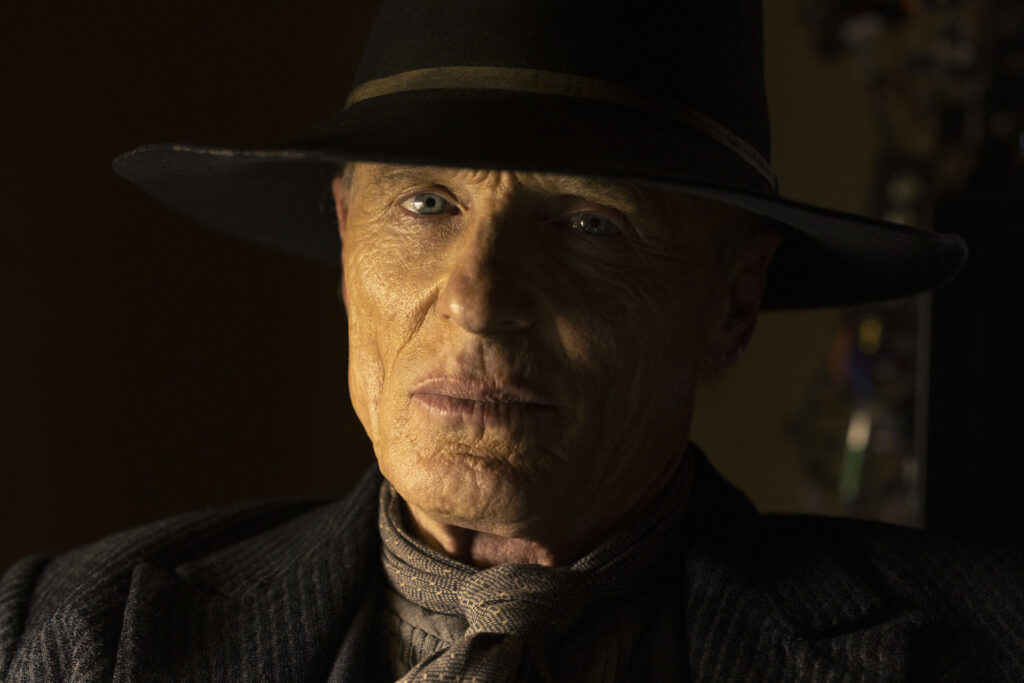
Plot Synopsis
According to WarnerMedia, here is the synopsis for Westworld Season 4 Episode 2— “Well Enough Alone”.
I heard a fly buzz when I died.
WarnerMedia
Discussion
It should be noted that I have seen the first four of eight episodes ahead of release.
“Well Enough Alone” paces by just as well as the Westworld Season 4 premiere. While it does seem to play off as an extension of the previous episode, this week’s episode does save itself during its final seventeen minutes. Otherwise, I found it to be rather decent. The series brings fans some wicked set designs and art directions. I am curious as to how Dan Caplan storyboarded the entire narrative.
This second episode foreshadows many albeit pivotal plot points that are teased in the season’s new introductory title sequence. In the opening scene of the premiere, we saw flies in a businessman’s home. Flies and their larvae will be important for this season, especially with what happens in next week’s episode and the one that follows. Be sure to keep an eye out for that…
Additionally, at one point in the episode, we see the mysterious spindle-sewing structure from the title sequence. We still do not know what it does exactly, although I am definitely sure it crafts something ominous. Beware of a vagabond on the streets who warns passersby of the damage that this tower will have on humans and other birds. That is all I can say about that without spoiling too much, that is, until perhaps next week’s episode.
I will be honest, though. Much of what I found terrific about the episode lies in its central theme of loneliness as well as the scenes involving Maeve Millay (Thandiwe Newton) and Caleb Nichols (Aaron Paul). Let’s dive into the former, then the latter.
Lebenswelt of Loneliness
The very concept of loneliness might be rather difficult to grasp. It is not solely the state of being alone but so much more. Since the first season, Westworld has been known to be a futuristic telling of inhuman figures usurping humanity a la The Invasion of the Body Snatchers. This time around, it is not easy to say that that is what’s happening.
The writers’ use of language via dialogue is noteworthy here and there. We see one guest character placed in a “barn” with other “livestock”. Upon entry of this reputed barn, characters find this person, who pleads for freedom. Unfortunately, they do not get exactly what they asked for. One antagonistic Host states their explicit intention for usurping humanity: “I want my people to be able to grow, flourish, to find their own identity [but i]t would be pointless to bring children into a world where they will be consumed by jackals”.
Here, we can assume that this “barn” is representative of the world — humans mixed in with animals but all treated as if sheep to be protected from predators, in this case, jackals. Could the jackals be the Hosts or the humans? Could it be that easy to determine?
Transhumanism and Posthumanism
In his critical text, Posthumanism, University of Hyperabad professor, Pramod K. Nayar differentiates the difference between what is transhuman and posthuman. Transhumanism is what transforms an individual from their human state to something more. In his text’s first chapter, Nayar explains:
[Transhumanism examines] the human as a construct enmeshed with other forms of life and treats technology as a means of “adding” to already existing human qualities and of filling the lack in the human. … an intermediate stage before the arrival of the advanced human form in which bodies and their intelligence might be enhanced for greater utility and purpose. … Transhumanism relies on human rationality as a key marker of “personhood” and individual identity, and sees the body as limiting the scope of the mind.
Pramod K. Nayar, Indian professor of the University of Hyperabad, in ‘Posthumanism’
In contrast, as I have stated in previous television episodic reviews — including one in May — posthumanism is the end goal of humanism that aims to use human invention and technologies to make living in a world with other species ideal and optimal.
One instance of posthumanism, while apparently seldom present in popular culture media, would be the final scene of Damon Lindelof’s Watchmen. It is implied that its protagonist wants to make the world a better place for everyone to live in, and they quite literally take the extra step to ensure that happens. Allow me to now draw your attention back to Westworld.
Welcome to the New Machine
As seen with the one individual in the barn, one character refers to them as “inhuman” and already dead, like the other livestock. The point made here is that posthumanism is never the goal, at least, not of the antagonist. This “barn” is not only a synecdoche of the world but moreover the overall Westernized or modernized society that comprises it.
During the Season 4 premiere, William, the Man in Black (Ed Harris), stated: “This is America”. From what I interpreted about the title sequence last week, the world has been transformed into a new machine, a Lebenswelt (German for Lifeworld) of loneliness. In the middle of this week’s episode, William recalls his time in Westworld, the insanity that it brought out of him, and how he felt naked and powerful: “We are all alone”. With the title sequence for this new season, humanlike figures are manufactured and placed into individual tubes. Yes, we are together as a society, and still, in a way, we are alone.
According to his essay in Machine, titled, “For a Neganthropology of Automatic Society”, Bernard Stiegler suggests that “human beings may always relapse, decay into simpler forms, that is, become inhuman”. How this happens is that we, as a society, have been influenced by technology — in Stiegler’s context, the Internet — to become an artificial crowd, automated herd, much like automatons. While William speaks of his spiral into madness, Stiegler writes of the crisis, mutation, metaphorphosis, all of which are considered metaphors. Stiegler adds: “When a triggering factor is also an outcome, we find ourselves within a spiral [which] can be very fruitful and worthwhile, or it can enclose us — absent new criteria — in a vicious circle … from bad to worse”.
Furthermore, Stiegler suggests that we have entered a postlarval state via metamorphosis. In other words, what is happening is “not biological, even if biology comes into play via biotechnology”. Hence, the flies that appear in this season are only teased in these first two episodes.
The Bottom Line
From here, I need to point to this critique of transhumanism/ inhumanism. Like the humans trapped in the barn, we also see the real William hooked to a machine. (Dear reader, this is no spoiler as we have seen him being replaced by the William Host in the Season 3 finale mid-credits scene.) There, a character tells him, “You are as close to a god as a man gets”. This could imply that we, as humans, possess the very power to change the world and reach a post-human state. Unfortunately, for myriad reasons, in real life, that isn’t where we are currently situated.
This real William who is hooked into a machine — whatever it seems to be — confirms that we cannot merely let go of technology. In his stead, Host William does have a monologue in the final scene about how society itself is traversing the spiral: “We aren’t revisiting the past; we’re recreating it. Welcome to the Golden Age”.
If you look at our current events, not only are we facing Civil War and Civil Rights issues again but just about everything else that we had fought for throughout history. The spiral is speeding up, and history has never been so haunting as much as it is now.
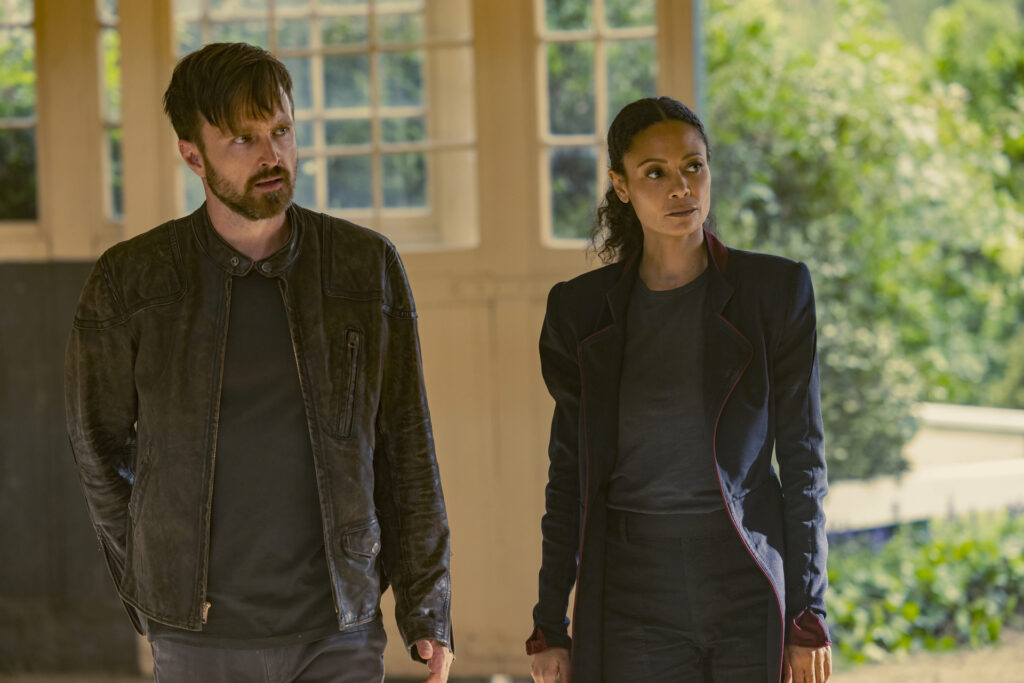
The Crew of Westworld
Westworld is created by Jonathan Nolan and Lisa Joy and is based on the film of the same name written by Michael Crichton.
Joy, Nolan, Ben Stephenson, Denise Thé, Alison Schapker, Richard J. Lewis, Athena Wickham, and J.J. Abrams serve as the executive producers. Matt Pitts and Mark Tobey serve as the co-executive producers; while Don Bensko, Jay Worth, and Noreen O’Toole serve as the producer. Kelly Calligan, Halle Phillips, Skye Wathen, Caleb Duffy, and Susan Ekins serve as the co-producers.
Peter Flinkenberg serves as the director of photography. Anna Hauger serves as the editor for the episode. Yoni Reiss and Philip Welch serve as the assistant editors for the episode.
Suzanne Wrubel serves as the story editor. Alli Rock serves as a staff writer on the show.
Ramin Djawadi scores the music for the series. Benjamin Cook is the sound designer, while Christopher Kaller serves as the music editor. Trygge Toven and Sean O’Meara are the music supervisors.
Jon Carlos serves as the production designer. Jay Worth is the visual effects supervisor, while Elizabeth Castro serves as the VFX producer. Mark Robert Taylor serves as the supervising art director. Chris DiLeo, Amelia Brooke, Rachel Aguirre, and Rebekah Scheys are the art directors. Michael Navarro, Elaine Jen, AJ Cisneros, and Jeanine A. Ringer are the assistant art directors.
Debra Beebe and Jo Kissack Folsom serve as costume designers. Margaret Robbs and Giorgia Tramontano serve as assistant costume designers.
Jose L. Zamora is the department head hairstylist. Michael Buonincontro and Lori Fenton serve as key hairstylists, while Dorchelle Stafford and Lorena Zamora are hairstylists. Elisa Marsh is the department head make-up artist.
Andrew Hull, Daniel Jennings, Sally Thornton, James Bolenbaugh, C. Scott Baker, and David Chow serve as the set designers. Dan Caplan is the storyboard artist. Julie Ochipinti serves as the set decorator, while Ellen Reede Dorros and Jane Madden are the assistant set decorators.
John Papsidera and Kim Winther are the casting directors of Westworld. Maddalena Zuppetta serves as the casting assistant. Bill Dance is the extras casting director, while Terance Harris is the extras casting associate.
In the New York unit, Barbara McNamara is the extras casting director. Rachel Musson is the extras casting associate, while Patrick Kline is the extras casting assistant. Geoffrey Ehrlich is the art director, while Lucy Pope is the assistant art director. Candice Cardasis is the set decorator. Ashleigh Williams is the head of the make-up department.
The Cast of Westworld
Evan Rachel Wood stars as the protagonist of Westworld, Christina, once known as Dolores Abernathy. Thandiwe Newton portrays Maeve Millay, while Aaron Paul portrays Caleb Nichols. Ed Harris portrays William, also known as the “Man in Black”.
Jeffrey Wright and James Marsden are credited as their respective characters, Bernard Lowe and Theodore “Teddy” Flood. Tessa Thompson and Angela Sarafyan portray Dolores Abernathy (previously Charlotte Hale) and Clementine Pennyfeather.
Ariana DeBose makes a guest appearance as Christina’s roommate, Maya.
Jack Coleman plays Senator Ken Whitney, while Saffron Burrows portrays his wife, Anastasia. José Zúñiga plays the Vice President of the United States. Josh Randall plays Jim Navarro, a deputy assistant attorney general for counter-terrorism from the United States Justice Department.
Liza Weil plays Deborah, while Lili Simmons makes her return, this time as a character named Sophia.
Manny Montana plays Carver, an associate of Maeve and Caleb’s. Michael Malarkey plays Emmett, Christine’s boss at Olympiad Entertainment. Aaron Stanford makes an appearance as Peter Myers.
Ted Monte co-stars as Arthur. Gabriel Bonilla plays Gerald. Justin Zachary plays a bartender, while Natalia Lazarus plays Rosa.
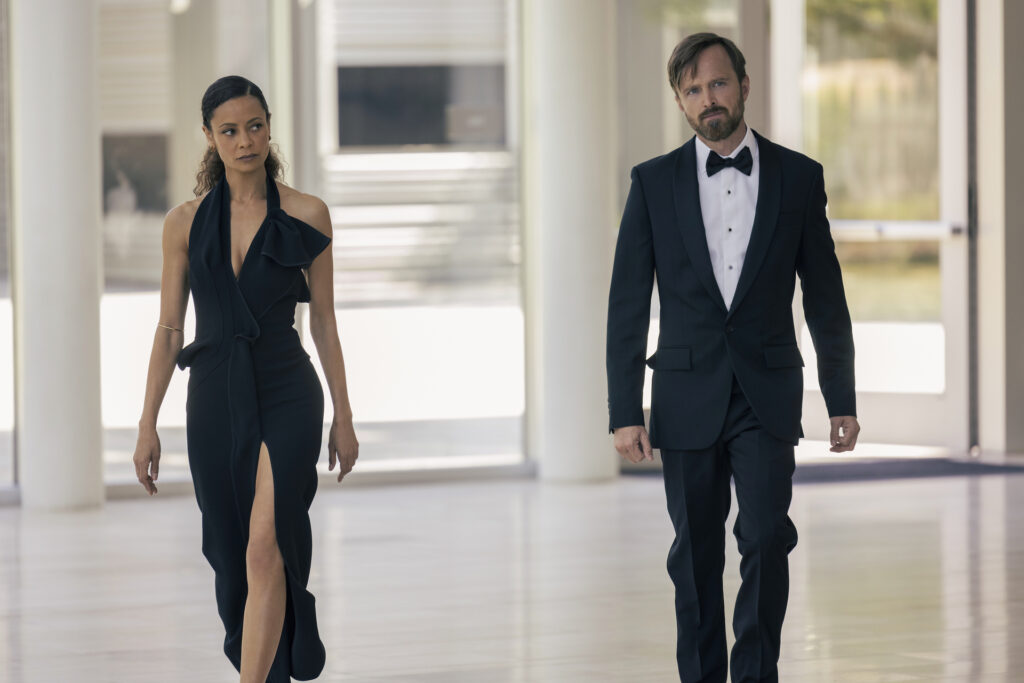
Performances and Character Developments
In my opinion, Newton’s Maeve and Paul’s Caleb Nichols steal the show. I love their dynamic in this season. Maeve is without a daughter, a lover, a family, friends, and allies, and because of his own past, the same has to apply to Caleb. These two characters complete each other, their respective milieu and experiences allowing them to bond. We do see that Caleb is human and Maeve is an automaton with humanlike traits. However, as we will see in the next couple of episodes, this might just be reversed.
Second to these two characters is Tessa Thompson’s return to the show. I admire her role in Westworld this time around, and with what she has to offer to the other characters, I am sure fans will be excited to see some riveting performances from the actor prior to her appearance in Thor: Love and Thunder. There is no preparing for what Thompson has in store for the show. I am in awe at how different she is from her portrayals of Charlotte Hale in Seasons 1 & 2 along with Dolores Abernathy in Season 3.
Lastly, I would be lying if I did not say I am in love with Simmons and her portrayal of Sophia. She can be alluring when necessary, and I am hoping she has a larger role during the rest of the season. For now, just watch what she does in this episode as it could tease her part in the bigger picture.
Final Thoughts on This Week’s Westworld
If it isn’t for this analysis review, I would perceive “Well Enough Alone” as somewhat dull, and in a manner of speaking, well enough alone from the rest of the season. Towards the end of the episode, there is a namedrop of the surname, Morgan. This is the last name attributed to a protagonist from the Red Dead Redemption video game franchise. Of course, this could be a reach and could just mean anything. With that said, I did find an Easter Egg referencing one of the show’s art directors in next week’s episode. We will get to that soon.
On a more important note, we see Christina’s (Evan Rachel Woods) actions and whereabouts being surveilled by her Olympiad Entertainment boss, Emmett (Michael Malarkey). Not only is this an invasion of her privacy, but this is also an impingement on her human rights. From what I said last week about the control over women’s bodies, this looks to be an extrapolation of that.
Overall, this is a decent episode of Westworld that sets up the arrival of the new machine. Stay tuned next week, when the depictions begin to fortify…
Westworld Season 4 is now airing on HBO!
Have you seen Nolan and Joy’s series? If so, then what are your thoughts on it so far? Let us know! For more Westworld updates as well as drama and science-fiction-related news and reviews, don’t forget to follow The Cinema Spot on Facebook, Twitter, and Instagram!
Managing editor & film and television critic with a Bachelor's of Arts in English Literature with a Writing Minor from the University of Guam. Currently in graduate school completing a Master's in English Literature.


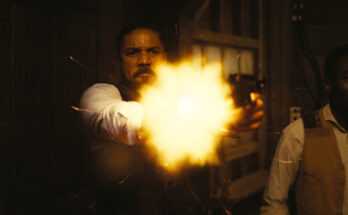
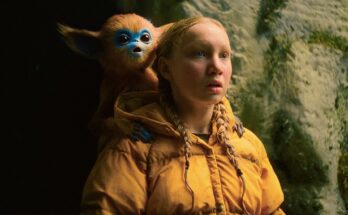
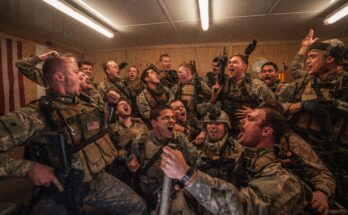
10 Comments on “‘Westworld’ Season 4 Episode 2 Non-Spoiler Review — “Well Enough Alone””